This page is based on this
Wikipedia article Text is available under the
CC BY-SA 4.0 license; additional terms may apply.
Images, videos and audio are available under their respective licenses.
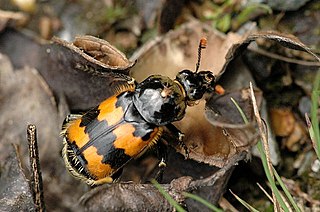
Silphidae is a family of beetles that are known commonly as large carrion beetles, carrion beetles or burying beetles. There are two subfamilies: Silphinae and Nicrophorinae. Nicrophorines are sometimes known as sexton beetles. The number of species is relatively small and around two hundred. They are more diverse in the temperate region although a few tropical endemics are known. Both subfamilies feed on decaying organic matter such as dead animals. The subfamilies differ in which uses parental care and which types of carcasses they prefer. Silphidae are considered to be of importance to forensic entomologists because when they are found on a decaying body they are used to help estimate a post-mortem interval.
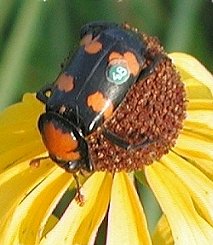
Burying beetles or sexton beetles are the best-known members of the family Silphidae. Most of these beetles are black with red markings on the elytra (forewings). Burying beetles are true to their name—they bury the carcasses of small vertebrates such as birds and rodents as a food source for their larvae. They are unusual among insects in that both the male and female parents take care of the brood. They are carnivores.

Nicrophorus americanus, also known as the American burying beetle or giant carrion beetle, is a critically endangered species of beetle endemic to North America. It belongs to the order Coleoptera and the family Silphidae. The carrion beetle in North America is carnivorous, feeds on carrion and requires carrion to breed. It is also one of the few species of beetle to exhibit parental care. The decline of the American burying beetle has been attributed to habitat loss, alteration, and degradation, and they now occur over less than 10% of their historic range.
Nicrophorus bipunctatus may refer to the beetles:
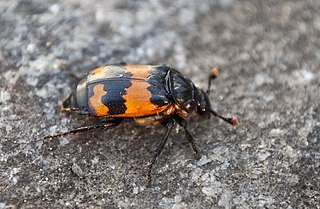
Nicrophorus investigator is a burying beetle described by Swedish naturalist Johan Wilhelm Zetterstedt in 1824.

Nicrophorus vespilloides is a burying beetle described by Johann Friedrich Wilhelm Herbst in 1783.

Nicrophorus vestigator is a species of beetle belonging to the family Silphidae.
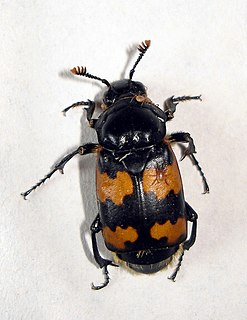
Nicrophorus vespillo is a burying beetle described by Linnaeus in 1758.
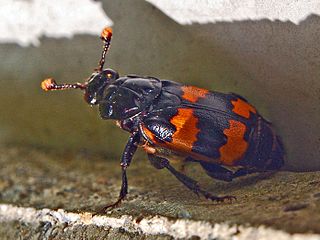
Nicrophorus interruptus is a species of burying beetle or sexton beetle belonging to the family Silphidae subfamily Nicrophorinae.
Nicrophorus defodiens is a burying beetle described by Mannerheim in 1846.
For the species misidentified by Lafer in 1989 and declared a new species under the name Nicrophorus insularis, but later corrected, see Nicrophorus investigator

For the species misidentified by Gyllenhal in 1827 and declared a new species under the name Nicrophorus sepultor, but later corrected, see Nicrophorus vestigator
Nicrophorus satanas is a burying beetle described by Edmund Reitter in 1893.
Nicrophorus cadaverinus is not currently a valid species name, although the name has been applied independently to three different Nicrophorus species, each of which had already been described an alternate name:
Nicrophorus funerarius may be a species of burying beetle described by Weigel in 1808. It is not yet verified that this species is unique from other species of Nicrophorus.
Nicrophorus orientalis may refer to:
Nicrophorus pollinctor may refer to:
N. vulgaris may refer to:
N. frontalis may refer to:
The Reverend Andrew Matthews, M.A. was a British clergyman and an entomologist who specialised in beetles (Coleoptera).









